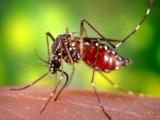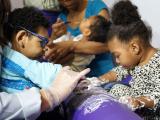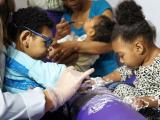More than 2.17 billon people live in tropical and subtropical regions of the world that are suitable for Zika virus spread, according to new mapping estimates that researchers say could be useful for crafting public health guidelines, travel advisories, and other preparedness steps.
In other developments, researchers reported more findings on the Zika virus’s structure, which suggest that its compact surface area might help it survive in various body fluids, and the World Health Organization (WHO) revealed clinical details about the first two cases in Saint Lucia.
Potential impact in Americas
The Zika mapping study by an international group of researchers is based on what's known about conditions in countries that have already experienced outbreaks, modeling projections that have been used for other vectorborne diseases, and other environmental factors thought to be important for Zika transmission. High spatial-resolution data enabled the team to make and display its global projections. They published their findings yesterday in the online journal eLife.
They emphasized that environmental suitability doesn't necessarily mean the virus will arrive or spread in a location.
Large parts of the Americas could support Zika transmission, especially Brazil, Colombia, and Venezuela, which have already reported outbreaks. In Brazil, coastal cities in the south and large parts of the north are at highest risk, but population density and smaller mosquito populations make for a smaller risk in the central part of the country.
In the United States, a large swath of the southeastern region, including a large part of Texas and all of Florida, is highly suitable for Zika transmission.
Researchers also predicted that 5.42 million births would occur in vulnerable parts of the Americas over the next year.
Parts of India, Africa, Asia also vulnerable
Much of sub-Saharan Africa could support Zika activity, and though no cases have been reported in India, a large portion of the country is at risk, from the northwest to Bangladesh and Myanmar.
Southeastern China and Indonesia also have large suitable regions, and even northernmost Australia was found to be at risk.
Regarding population numbers at risk, Asia had the most people living in high-risk areas, a large portion of them in India: 1.42 billion. Africa followed, with 453 million, many of them in Nigeria.
In the Americas, 298 million people live in areas favorable to Zika transmission, 40% of them in Brazil. The team noted that some parts of the Americas, such as southern Brazil, Argentina, and the United States, wouldn't have -year-round suitability.
The researchers concluded that many questions about Zika virus remain, but the maps can be used as a baseline for tracking the disease and can help focus limited resources for prevention and targeting high-risk areas for public messaging about how individuals can reduce their risk, especially during the first wave of illnesses.
Zika structure study, St. Lucia cases
- Cryo-electron microscopic examination of Zika virus by researchers from Singapore revealed that the structure is similar to other flaviviruses, but with envelope (E) protein that resembles two members of the family that can cause neurologic disease: West Nile and Japanese encephalitis viruses. Publishing their findings yesterday in a letter to Nature, the investigators said the virus particle was more stable than dengue virus at high temperature and has a more compact surface, which might help its survival in harsh environments such as semen, saliva, and urine.
- The World Health Organization (WHO) today shared details on the first two local Zika virus cases reported from St. Lucia. Both patients got sick in March and are from Castries district. They are a 25-year-old man and a 28-year-old woman who was 9 weeks pregnant during her illness.
See also:
Apr 19 eLife abstract




















